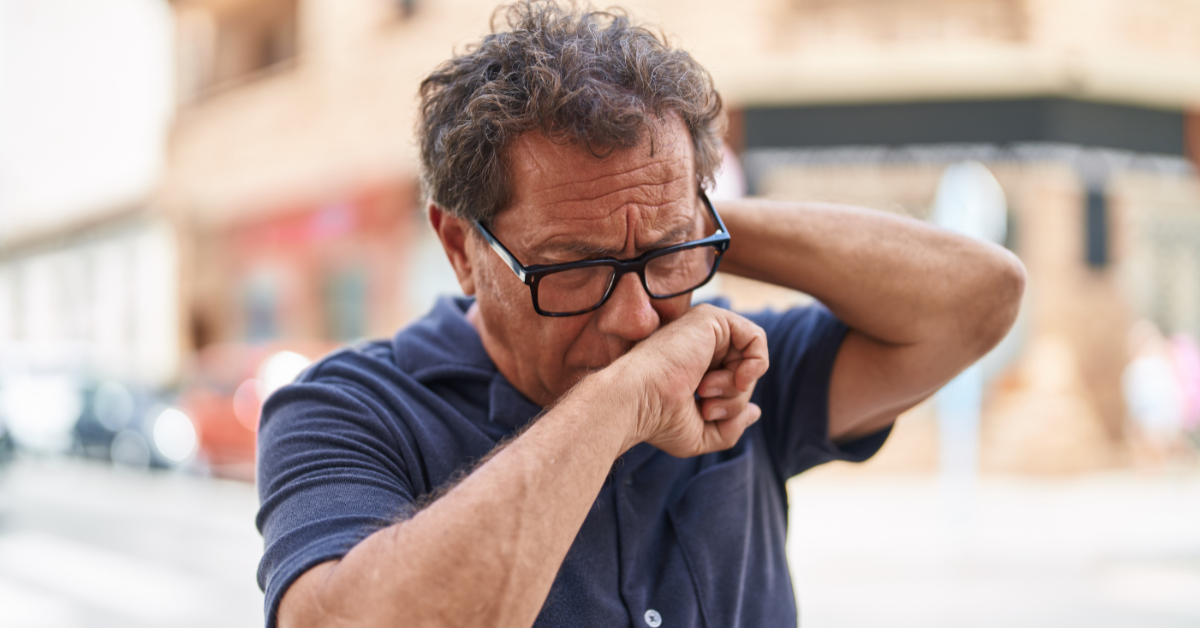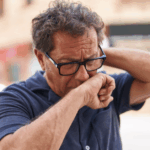Two neighbors. Two lives. One grows up surrounded by leafy parks and quiet cul-de-sacs. The other, just a few miles away, lives next to a highway that never sleeps and a row of old factories whose chimneys shadow the sky. Both call the same city home, but they’re breathing two very different versions of it.
By adulthood, the difference shows up not only in their lungs, but in their life expectancy. Across America, your ZIP code can be a stronger predictor of health than your genetic code.1
And when it comes to lung cancer, where you live, the air you breathe, the roads you drive, and the industries nearby can quietly shape your risk, even if you’ve never smoked a cigarette in your life.2
What Is Lung Cancer, Really?
Lung cancer begins when cells in the lungs grow uncontrollably, forming tumors that interfere with breathing and can spread throughout the body.3 There are two main types:
- Non-Small Cell Lung Cancer (NSCLC), the most common and slower-growing form.3
- Small Cell Lung Cancer (SCLC), which spreads faster and is often diagnosed at later stages.3
Early symptoms, like shortness of breath, hoarseness, chest pain, or fatigue can be easy to ignore.3 That’s why prevention and detection matter so much.
For decades, smoking was viewed as the singular cause. But today, we know better: environmental exposure plays a powerful, often overlooked role.2
When the Air You Breathe Isn’t Equal
Air pollution isn’t distributed evenly. According to the American Lung Association, in the U.S., 46% of people live in an area that received a failing grade for at least one of the air pollutants included – ozone pollution, short-term particle pollution and year-round particle pollution.4 That’s about 156 million people in total who are breathing unhealthy air.4
ALA’s “State of the Air” report also found that communities of color are disproportionately exposed to unhealthy air.4 That’s not coincidence, it’s history.
Decades of redlining, discriminatory zoning, and industrial placement forced Black and Brown families into areas near factories, landfills, and busy roadways.5 These same neighborhoods still record the highest levels of fine-particle pollution (PM2.5), diesel exhaust, and chemical runoff today.5
In cities like Atlanta, Chicago, and Los Angeles, life expectancy can differ by 10 to 15 years between ZIP codes, depending on how close you live to a major road or refinery.6
The truth is simple but devastating: the air we breathe reflects the policies we’ve inherited.
These patterns of environmental racism mean that the communities least responsible for pollution often bear its heaviest health costs: higher asthma rates in children, more chronic bronchitis, and, increasingly, greater lung-cancer risk.5
This leads us to the crucial question: How exactly does your ZIP code translate into a lung cancer diagnosis?
How ZIP Code Becomes a Lung Cancer Risk
Every neighborhood has its own environmental fingerprint. Unique combinations of air, soil, and housing that shape exposure over a lifetime. Here are the biggest ways your surroundings can quietly raise your lung-cancer risk.
1. Air Pollution and Fine Particles (PM2.5)
The invisible dust you can’t see may be the most dangerous of all. Fine particulate matter, known as PM2.5, comes from car exhaust, factories, and even wildfire smoke.2 These microscopic particles are smaller than a single red blood cell and can travel deep into the lungs and bloodstream.2
Over time, PM2.5 causes chronic inflammation and oxidative stress, damaging cells and creating a fertile ground for cancer.2 Researchers recently discovered that pollution doesn’t just cause new mutations, it can “wake up” dormant cancer cells that already exist in the lungs, particularly among people who’ve never smoked.2
Neighborhoods closest to freeways, industrial zones, or ports, often home to working-class and minority residents, consistently record the highest PM2.5 levels.2 Breathing that air day after day isn’t just uncomfortable; it can severely increase your chances of developing lung cancer.2
2. Radon Gas Lurking Indoors
Radon is an invisible, odorless radioactive gas that seeps up from the soil and can accumulate in homes.7 It’s the second leading cause of lung cancer in the United States, responsible for more than 21,000 deaths each year.7
Older buildings, basements, and homes with poor ventilation are most vulnerable.8 Because many Black and Brown families live in older housing or rental properties where landlords neglect testing, radon exposure often goes undetected for decades.8
Testing is simple and inexpensive, yet access remains unequal.8 In affluent areas, radon checks are standard during home sales; in under-resourced neighborhoods, they’re a rarity.8 That oversight can mean the difference between prevention and a diagnosis.
3. Diesel Exhaust and Traffic Corridors
If your alarm clock is drowned out by the hum of trucks, you’re breathing more than city noise. Living within a few hundred feet of a major roadway exposes you to diesel exhaust, which contains tiny particles coated in carcinogenic hydrocarbons.9
Diesel fumes cause chronic inflammation, scarring, and DNA damage in lung tissue.9 The World Health Organization classifies diesel exhaust as a Group 1 carcinogen, the same category as tobacco smoke and asbestos.9
Across the South and Midwest, predominantly Black neighborhoods are often carved between highways or freight routes—a relic of redlining and highway expansion projects that bulldozed through once-thriving communities.5 Those same routes now carry pollution that seeps into bedrooms, playgrounds, and lungs.5
4. Industrial and “Legacy” Contamination
Factories, refineries, chemical plants, and former military bases release a toxic mix of heavy metals, solvents, and asbestos into the environment. Even long after facilities close, these pollutants linger in soil and groundwater.10
Residents living near these “legacy sites” face higher rates of lung cancer, COPD, and other respiratory illnesses.10 Cleanup programs are slow, and corporate accountability is uneven. Meanwhile, property values and the people who live there carry the burden.10
For Black and Brown families who’ve lived in these areas for generations, exposure isn’t a one-time event, it’s a continuous inheritance.5
5. Housing Conditions and Secondhand Smoke
In multi-unit buildings, smoke doesn’t stay in one apartment. It drifts through vents, hallways, and cracks in the walls. Adults exposed to secondhand smoke have a 20–30 percent higher risk of developing lung cancer, even if they’ve never smoked.2
HUD banned smoking in public housing in 2018, but enforcement is inconsistent. Many residents, often older adults or families with asthma-prone children, still report exposure from neighboring units. Clean indoor air shouldn’t depend on who lives next door.2
What You Can Do Right Now
You can’t change your ZIP code overnight, but you can take action to protect your health and your community starting today.
1. Know Your Air
Visit AirNow.gov or download the app to check your local Air Quality Index (AQI). On days rated “orange” or “red,” limit outdoor activity, especially for children, seniors, and anyone with asthma or heart conditions.11
2. Test for Radon
Purchase a $20 radon kit from a hardware store or request one from your state’s environmental agency. If levels exceed 4 picocuries per liter (pCi/L), hire a certified mitigator to install a vent system that draws radon safely outside.11
Renters can ask landlords to test or seek support from local housing authorities.11
3. Reduce Indoor Pollutants
Open windows when cooking, switch to low-VOC cleaning supplies, avoid scented candles or incense, and keep air vents clear of dust.11 Simple ventilation improvements can reduce your exposure significantly. (ALA, 2024)
4. Advocate for Your Neighborhood
Join local community boards, attend town halls, or collaborate with neighborhood groups pushing for cleaner air policies, tree planting, and industrial regulation. Real change often starts with residents speaking up about what they’re living through.
5. Get Screened and Encourage Others
If you’re between 50 and 80 and have ever smoked, or if you’ve lived long-term near heavy pollution, talk to your doctor about a low-dose CT (LDCT) scan.12 It’s fast, noninvasive, and can catch lung cancer in its earliest stages.12
If cost or access is a concern, ask about community-based screening programs or free mobile screenings in your area.
A Call to Action
Your lungs record more than breaths, they record history. The cars that idle outside your window, the soil beneath your home, the choices made decades before you were born—all leave a trace.
But awareness is power. When you know your environment, you can change your outcomes.
Check your air. Test your home. Demand cleaner policies. And join a community that refuses to normalize preventable conditions.
References
- Khan, S. U. (2024). Zip Code Health Disparities: Mapping Cardiovascular Inequities at the Neighborhood Level. Methodist DeBakey Cardiovascular Journal. doi:10.14797/mdcvj.1457
- Berg, C. D., Schiller, J. H., Boffetta, P., Yang, D., & Lam, S. (2023). Air Pollution and Lung Cancer: A Review by International Association for the Study of Lung Cancer Early Detection and Screening Committee. Journal of Thoracic Oncology. doi:10.1016/j.jtho.2023.05.024
- ACS. (2024, January 29). What Is Lung Cancer? Retrieved from American Cancer Society: https://www.cancer.org/cancer/types/lung-cancer/about/what-is.html
- ALA. (2025, April 23). Nearly Half of People in the U.S. are Breathing Polluted Air—Are You at Risk? Retrieved from American Lung Association: https://www.lung.org/blog/sota-pollution-health-risks
- Skelton, R., & Miller, V. (2025, August 14). The Environmental Justice Movement. Retrieved from The Natural Resources Defense Council: https://www.nrdc.org/stories/environmental-justice-movement
- RWJF. (2025). What makes a long life? Look to your ZIP Code. Retrieved from Robert Wood Johnson Foundation: https://www.rwjf.org/en/insights/our-research/interactives/whereyouliveaffectshowlongyoulive.html
- EPA. (2025, February 27). Health Risk of Radon. Retrieved from U.S. Environmental Protection Agency: https://www.epa.gov/radon/health-risk-radon
- Dai, D., Jelks, N. O., & Smith, G. P. (2026). Participatory science to action: Radon literacy assessment and testing in an African American community. Journal of Environmental Radioactivity. doi:https://doi.org/10.1016/j.jenvrad.2025.107842
- ACS. (2024, February 26). Diesel Exhaust and Cancer Risk. Retrieved from American Cancer Society: https://www.cancer.org/cancer/risk-prevention/chemicals/diesel-exhaust-and-cancer.html
- ALA. (2019, January 23). Are There Environmental or Health Factors that Can Cause Lung Cancer? Retrieved from American Lung Association: https://www.lung.org/blog/environmental-factors
- ALA. (2024, September 18). 10 Tips to Protect Yourself from Unhealthy Air. Retrieved from American Lung Association: https://www.lung.org/clean-air/outdoors/10-tips-to-protect-yourself
- CDC. (2024, October 15). Screening for Lung Cancer. Retrieved from Centers for Disease Control and Prevention: https://www.cdc.gov/lung-cancer/screening/index.html







